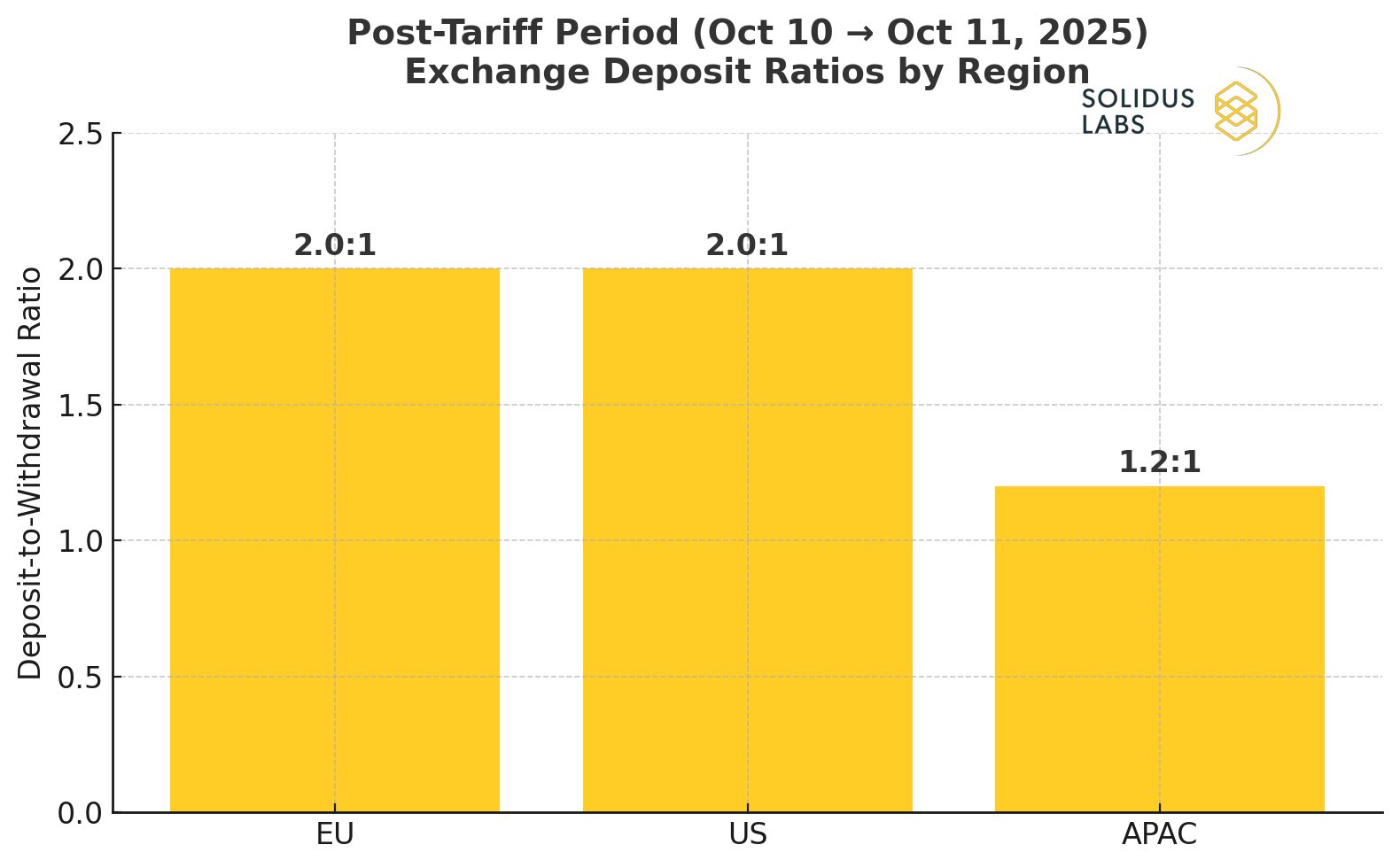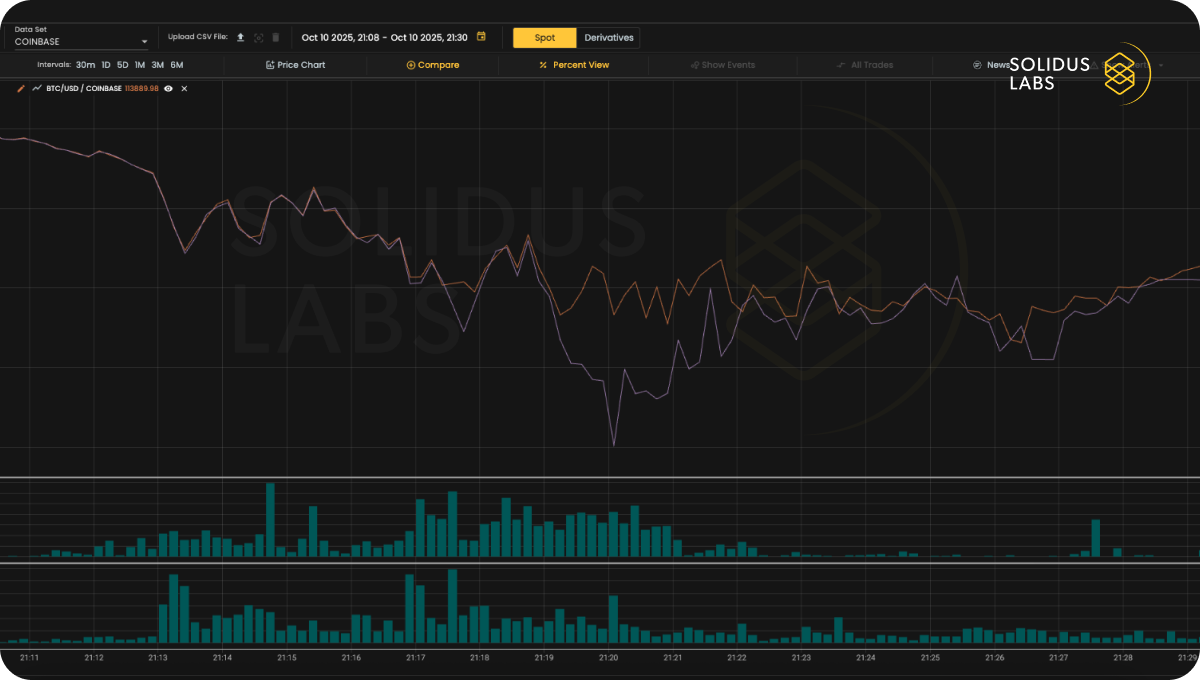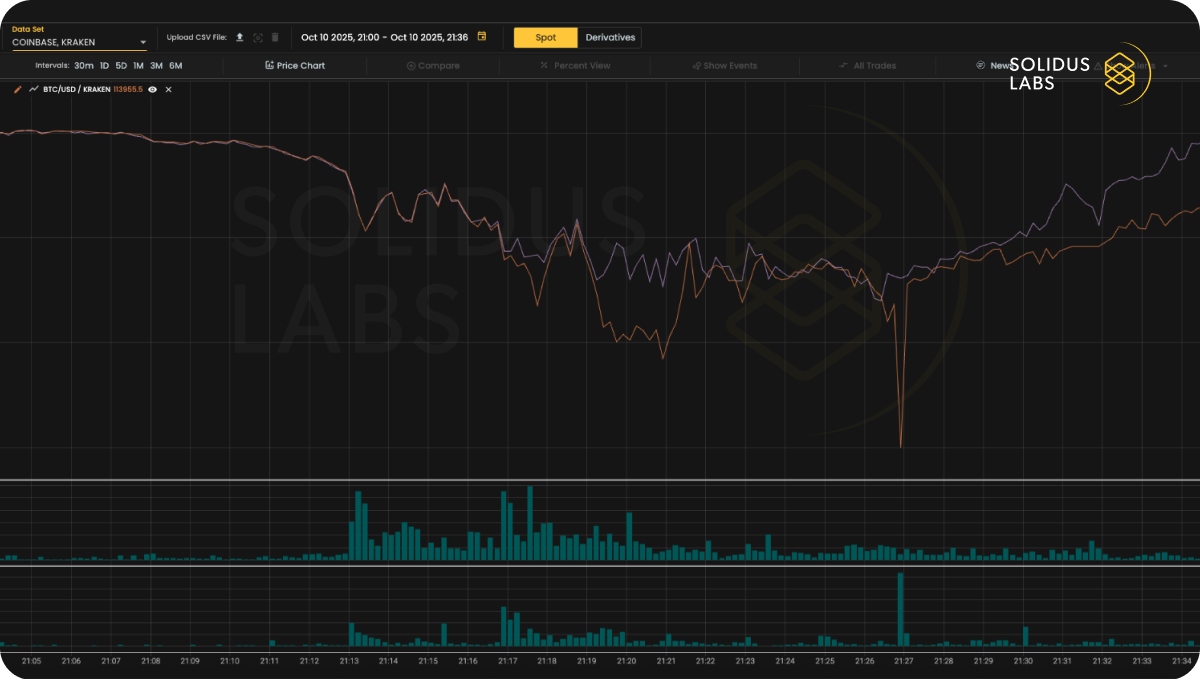In the past 24 hours, nearly $20 billion in crypto positions were liquidated across major exchanges, a move so violent and sudden that it sent tremors through every corner of the digital-asset ecosystem. What began as a macro headline, the U.S. imposing 100 percent tariffs on Chinese software imports, quickly escalated into a liquidity shock, exposing the structural fragility of today’s crypto markets.
As traders scrambled to unwind positions, reports surfaced of delayed order execution and halted trades, with exchange systems struggling to process the surge in volume. Some saw chaos; others saw choreography. Blockchain analysts have since traced large short positions opened hours before the tariff announcement, positions now sitting on multi-million-dollar profits.
At Solidus Labs, we see this not as another volatility episode, but as a defining market-integrity moment for the industry.
Behavior Under Scrutiny
In the immediate aftermath of the crash, Crypto.com CEO Kris Marszalek publicly called for regulators to investigate whether exchanges that experienced the largest liquidations had “slowed or frozen trading, mispriced assets, or lacked adequate anti-manipulation controls.”
According to CoinGlass data cited in multiple reports, Hyperliquid led with roughly $10.3 billion in liquidations, followed by Bybit with $4.65 billion, and Binance with approximately $2.41 billion. Combined, these three venues accounted for an overwhelming share of global losses within hours.
The scale and concentration of the liquidations underscore how exchange-level mechanics, rather than purely macroeconomic forces, can amplify systemic stress.
The Hidden Signals: What Solidus Cross On- and Off-Chain Data Exposed About the East-West Deposit Divide
Beyond price charts and liquidation tallies, Solidus’ cross on- and off-chain analytics reveal how traders and institutions actually moved capital in the aftermath of the sell-off. During the Post-Tariff Period (Oct 10 → Oct 11, 2025), Solidus’ proprietary dataset, spanning centralized exchanges, DeFi protocols, and institutional wallet flows, uncovered a striking regional divide in exchange deposit behavior.
Globally, deposits outpaced withdrawals by roughly 1.6 to 1, suggesting that participants were not uniformly de-risking. Yet beneath that global average, capital sentiment diverged sharply:
- Europe and the United States emerged as net depositors, with inflows roughly double their outflows. Western desks appeared to interpret the tariff news as a tactical opportunity, redeploying capital to capture volatility.
- APAC, by contrast, showed near-neutral behavior, around 1.2, indicating a more defensive posture amid concern over secondary economic impacts from the U.S.–China tariff escalation.
This East-West deposit divide reflects what we call a confidence bifurcation: Western markets treating disruption as opportunity, while Eastern participants remain cautious.
From a market-integrity perspective, this divergence also suggests differences in venue controls and risk appetite. While Western venues appeared to absorb inflows and maintain leverage accessibility, several APAC venues likely tightened internal exposure limits, an early signal of how structural risk management and behavioral confidence intersect under stress.
Solidus Data Insight: Post-Tariff Deposit Ratios Reveal an East–West Confidence Divide (Oct 10 → Oct 11, 2025)

The Core Issue: Market Integrity in Times of Stress
When volatility surges, the market’s plumbing is put to the test. Market integrity isn’t just about catching manipulators after the fact, it’s about ensuring the mechanisms of fair trading hold under the most extreme conditions.
In traditional markets, flash crashes trigger a layered defense system: pre-tested circuit breakers, cross-venue surveillance, and automated controls that detect and isolate manipulation in real time.
In crypto, however, these safeguards remain inconsistent, fragmented, and often opaque, particularly across centralized venues. By contrast, some DeFi protocols appeared to weather the stress event with orderly, transparent liquidations, a reminder that verifiable market design can reinforce integrity when volatility spikes.
During this liquidation event, analysts observed that Hyperliquid appeared to play an outsized role in forced liquidations, suggesting the crash may have been shaped, in part, by venue-specific execution or liquidation mechanisms, not just macro volatility.
One critical example is Auto-Deleveraging (ADL), a mechanism used when an exchange runs out of liquidity to close out losing positions.
When an exchange is unable to liquidate underwater positions naturally, it triggers ADL, which forces profitable positions to close prematurely in order to maintain solvency. In other words, winners are partially “deleveraged” to offset the losses of insolvent counterparties. It’s an extreme measure — and a sign of systemic stress — because it punishes successful traders simply to preserve market balance.
This phenomenon is particularly acute in perpetual futures markets, which are inherently zero-sum systems. If all the losing shorts (or longs) are out of margin, there may simply not be enough capital to pay the winners — resulting in forced deleveraging, dislocation, and outsized volatility.
For any regulated market, such a concentration of stress would be a red flag. In crypto, it’s a wake-up call.
What Raises the Manipulation Concern
The scale and speed of the liquidations — combined with reports of order delays and halted trading — have fueled concerns that the crash may have been exacerbated by exchange-level anomalies, not just market-driven volatility.
Marszalek’s call for regulatory scrutiny highlights a crucial nuance: even if the trigger was external, how exchanges responded in real time could have materially impacted market fairness. The concentration of losses on a few platforms also suggests that certain systems or internal practices may have magnified cascading effects, further destabilizing prices.
In other words, the industry is confronting a deeper integrity question: not whether manipulation occurred, but whether the market’s infrastructure itself enabled disproportionate outcomes.
The Challenge of Fragmented Liquidity
The decentralized and global nature of the crypto industry fuels innovation and accessibility — but it also introduces unique challenges, particularly when liquidity becomes fragmented across multiple venues. Today’s crypto markets depend heavily on market makers to maintain consistent pricing across exchanges and trading pairs. Under normal conditions, this mechanism functions effectively. However, during periods of high volatility — often triggered by major global events — liquidity fragmentation makes it difficult to establish a clear and unified market price.
For instance, during recent market stress, Bitcoin price discrepancies across exchanges and trading pairs reached up to 10%. On Coinbase, the BTC/USD and BTC/USDT pairs diverged by as much as 5%, while on Kraken, BTC/USD traded nearly $10,000 higher than on Coinbase. Such distortions don’t just affect traders, they ripple across the ecosystem.
Coinbase BTC/USD vs BTC/USDT

Coinbase vs Kraken

Beyond the basic best execution concerns associated with trading at these times, this creates a couple of broader challenges that financial market participants must deal with:
- Benchmark Pricing: Investors, exchanges, and regulators rely on benchmark prices for derivative valuation, ETF pricing, and market abuse detection. When related symbols and exchanges diverge significantly, determining a “true” market price becomes increasingly complex and potentially misleading.
- Exchange Connectivity: The crypto landscape’s hybrid structure, spanning centralized order books, decentralized liquidity pools, and off-exchange OTC flows, means that liquidity can vanish or migrate across systems within seconds. The ease with which new decentralized venues emerge and attract liquidity further complicates continuity and oversight, creating visibility gaps for traders and compliance teams who lack access to robust market data.
- Market Integrity Risks: Fragmented liquidity makes it difficult to distinguish between organic volatility and manipulative intent. When identical instruments exhibit multi-thousand-dollar discrepancies, even sophisticated surveillance systems struggle to determine whether market behavior reflects inefficiency or exploitation.
Ultimately, fragmented liquidity undermines both price discovery and investor confidence. As crypto markets mature, solving these challenges will require greater transparency, standardized pricing mechanisms, and an integrated data infrastructure that bridges onchain and offchain liquidity pools
Information Moves Markets — Before the News Does
While liquidation engines and leverage mechanics explain how volatility spread, they don’t explain when it began. The sequence of trades preceding the crash suggests that information timing — not just leverage — played a decisive role.
Just a week before the tariff announcement, the U.S. government quietly took stakes in rare-earth metals companies, a move seen as an early signal of escalating trade measures against China. That policy step was publicly disclosed only later, but it likely set the stage for portfolio repositioning well ahead of the official tariff news.
The timing of the announcement — late on a Friday, when most global markets were closed — further amplified the reaction. With limited liquidity outside the U.S., price swings became sharper, creating ideal conditions for volatility spikes across derivatives and crypto assets.
This interplay between information flow, liquidity, and timing asymmetry isn’t unique to crypto. Just yesterday, reports surfaced that the Nobel Committee is investigating insider activity on Polymarket, after traders opened positions on the Venezuelan Peace Prize outcome hours before the official announcement.
When Whales Move Before the News
The emerging pattern of pre-positioned whale activity highlights the information asymmetry and opacity that still define crypto markets. Whether the positions were taken based on insider access, algorithmic foresight, or coincidence, the outcome was the same — billions in forced liquidations and an erosion of trust in fairness.
These “whale whispers” — the subtle, coordinated behaviors that precede major moves — are difficult to detect with traditional surveillance systems. They operate across exchanges, time zones, and instruments, exploiting latency gaps and liquidity vulnerabilities that human investigators can’t see in real time.
This isn’t the retail wash-trading of 2017. It’s institutional-grade manipulation, engineered to exploit market-microstructure inefficiencies — and it demands an equally sophisticated response.
Beyond Manipulation: The Need for Systemic Transparency
Liquidations of this scale don’t just hurt traders — they damage market credibility. Institutions and regulators observing from the sidelines see these episodes not as isolated incidents, but as evidence that the digital-asset ecosystem still lacks the systemic transparency and controls needed for mainstream adoption.
The question isn’t only who moved the market — it’s how the market allowed it to happen.
True market integrity requires visibility:
- Into how order books behave under stress, and where liquidity truly resides.
- Into whether algorithms and APIs execute fairly across user tiers.
- Into how internal market-making activity interacts with external participants during volatility spikes.
Without this transparency, even legitimate volatility begins to look like manipulation, and every whale trade becomes a potential integrity scandal.
What Traditional Markets Get Right: Circuit Breakers and Controls
In traditional finance, the Market-Wide Circuit Breaker (MWCB) system acts as a critical integrity safeguard — a mechanism designed to pause trading when markets experience extreme volatility. Established after the 2010 Flash Crash and jointly regulated by the SEC, CFTC, and FINRA, these coordinated halt rules ensure that rapid, cascading sell-offs do not destabilize the financial system.
Under the current framework, trading halts are triggered when the S&P 500 drops by:
- 7 % (Level 1) – 15-minute pause if before 3:25 p.m.
- 13 % (Level 2) – another 15-minute pause if before 3:25 p.m.
- 20 % (Level 3) – full-day trading halt.
Parallel price-limit controls exist for futures and derivatives under CFTC Regulation § 38.255 and exchange rules such as CME Rule 589.
These safeguards don’t just slow volatility — they preserve confidence in price discovery and give surveillance systems time to identify manipulative or errant trading behavior.
Crypto markets, by contrast, have no equivalent, coordinated integrity layer. Each exchange operates its own risk engine, liquidation model, and halt logic — if any — creating a patchwork of responses during market stress. The absence of shared controls leaves digital markets vulnerable to manipulation, contagion, and cascading failures that would be unacceptable in regulated markets.
Integrity Technology: Preventing the Next $20 Billion Meltdown
This is where technology must meet regulation. Surveillance tools can no longer be reactive; they must be proactive, cross-venue, and behavior-centric.
Solidus Labs’ approach to market integrity combines real-time surveillance, cross-venue manipulation detection, and behavioral analytics — enabling exchanges and regulators to identify emerging threats before they escalate into systemic events.
Our platform helps:
- Detect spoofing, wash trading, and layering in real time.
- Correlate liquidation patterns across venues to identify cross-market contagion.
- Apply behavior-based alerts that evolve dynamically with market conditions.
- Generate auditable integrity data to support post-event investigations and regulatory inquiries.
When surveillance is embedded at the infrastructure layer — not bolted on as an afterthought — markets gain resilience, and trust follows.
Rebuilding Confidence, One Integrity Layer at a Time
Crypto has reached its institutional inflection point. As liquidity deepens and oversight mechanisms evolve, market integrity will be the defining divide between who thrives and who fades.
Events like the $20 billion wipeout serve as reminders that price discovery means nothing without trust. The next frontier for crypto isn’t more trading volume or new token listings — it’s engineering integrity into the fabric of digital markets.
That means exchanges must view integrity as a competitive advantage, not a compliance checkbox. Regulators must embrace technology-first supervision, leveraging AI-driven surveillance and onchain analytics. And market participants must demand transparency and fairness as the baseline for participation.
Looking ahead, the conversation on integrity won’t stop at centralized exchanges. Onchain prediction markets and decentralized CLOBs—where price discovery and speculation merge in real time—are already testing the boundaries of transparency and fairness. Their open design is powerful, but it also introduces new risks: when everything is visible, timing and access become the new asymmetry.
The challenge for the next phase of crypto’s evolution is clear: to make transparency trustworthy—to ensure that open doesn’t become exploitable, and that innovation in market design reinforces, rather than erodes, integrity.
Because when whales whisper — and markets listen — it’s not just a question of who profited. It’s a question of whether the ecosystem is ready to grow up.
About Solidus Labs
Solidus Labs is the category-definer for crypto-native trade surveillance and risk monitoring. Whether it’s supporting your crypto trading, introducing tokenized assets, or offering stablecoin services, Solidus Labs is your bridge to digital-asset compliance - combining cutting-edge detection technology with unmatched expertise in crypto markets.
FAQs
What caused the $20 billion crypto market crash in October 2025?
The crash was triggered by the U.S. imposing 100% tariffs on Chinese software imports. However, Solidus Labs’ analysis suggests that pre-positioned whale trades and exchange-level liquidation mechanics significantly amplified the impact
Which exchanges saw the largest liquidations?
According to CoinGlass, Hyperliquid led with $10.3B in liquidations, followed by Bybit ($4.65B) and Binance ($2.41B), making up the majority of global losses.
What is Auto-Deleveraging (ADL), and how did it affect the crash?
ADL is a mechanism used when exchanges lack liquidity to close losing trades. It forces winning positions to close prematurely to offset losses, signaling systemic stress. ADL likely played a major role in this event.
Was there market manipulation involved in the crash?
While direct manipulation hasn’t been confirmed, Solidus Labs flagged suspiciously timed whale trades that occurred before the public tariff announcement. These may indicate exploitation of information asymmetry.
How did East vs. West respond to the crash?
Solidus data shows Western traders were net depositors, treating volatility as opportunity, while APAC desks were more cautious. This East-West divide reflects confidence, risk appetite, and venue-level controls.
What is Solidus Labs’ role in improving crypto market integrity?
Solidus Labs provides real-time cross-venue surveillance and behavior-based analytics, enabling exchanges and regulators to detect manipulation, analyze stress events, and ensure fair trading environments.







